Home-baked Dark Rye Bread - is there anything quite like it? This rich, aromatic bread is made with a 40/60 rye to bread flour mix and infused with molasses, cocoa, and a triple-seed mix for its distinctive flavor and color.
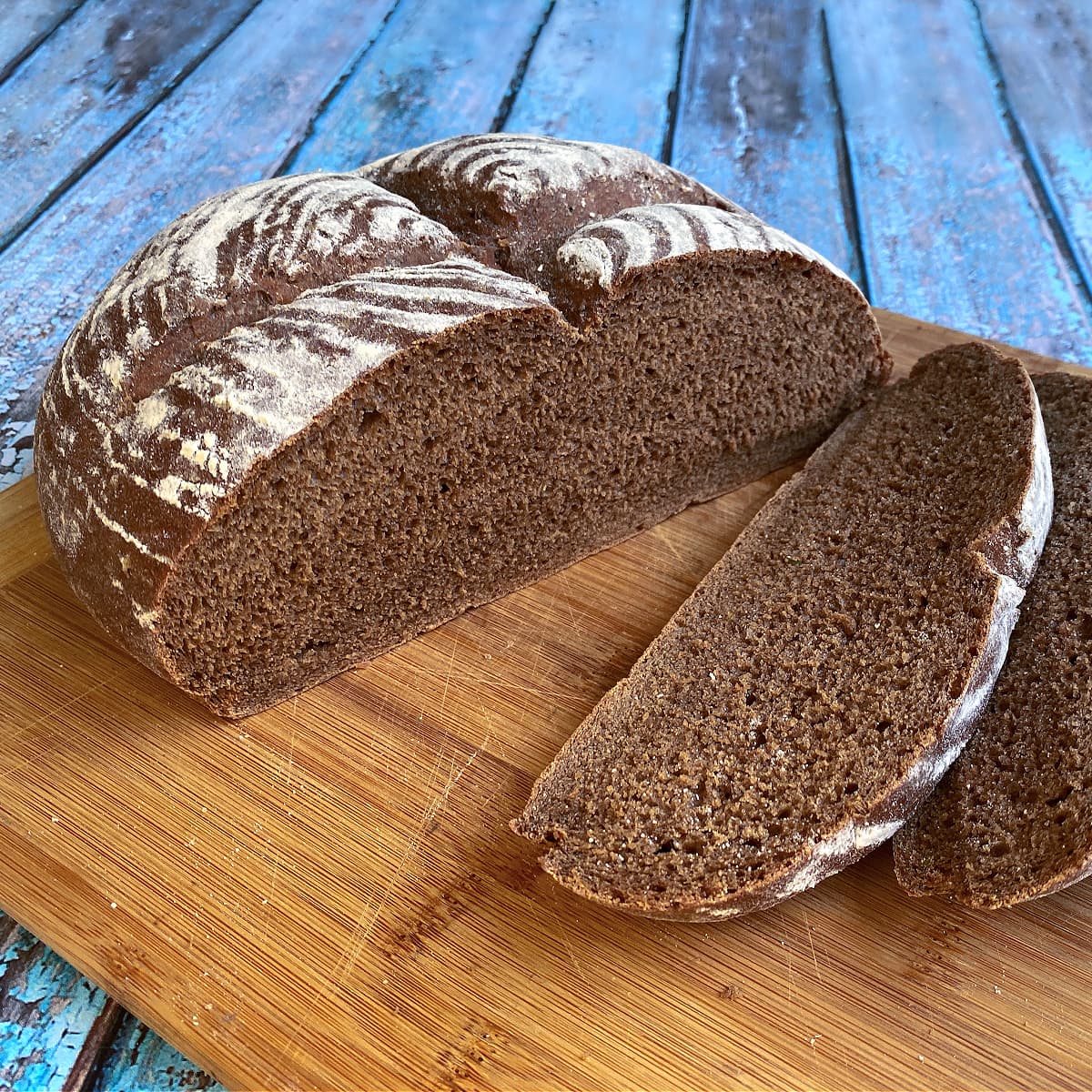
Jump to:
What's the Story Behind this Bread Recipe?
I am so excited to finally be able to share my German Dark Rye Bread recipe with you! Mr B and I both love rye bread, but it seems to be getting harder and harder to find a decent loaf of it, especially good dark rye bread. I started developing this recipe at least two years ago just to fill the void.
Mixing up rye bread is tricky, and I learned a lot about the chemistry of bread making during the process. Recipe ingredients must to be carefully considered and balanced just so to achieve the flavor balance and reaction you are going for.
In the end, creating this rye bread recipe took far longer to perfect (and many more test loaves) than I had imagined, but it was totally worth the effort, and I could not be happier with the final results! I hope you are, too.
Happy Baking!
Tips for Working with Mixed-Flour Rye Bread Dough
Authentic, Old World German Dark Rye contains only rye flour. It is thick and dense, with a tight, fine crumb. This is in part because rye flour contains far less gluten than wheat. Thus, breads made with all rye flour don't expand as much as those made with mostly wheat flour.
This recipe is a mixed-flour rye bread; about 40% rye flour and 60% wheat flour. This hybrid-style rye bread has the flavor and texture you are probably most familiar with when it comes to dark German rye, especially outside of Germany.
Kneading Dough Containing Rye Flour
If you typically make bread with white bread flour, you are used to kneading a dough that has some elasticity - a bit of bounce-back. Think of white flour bread dough as an innerspring mattress.
In that light, mixed-flour rye dough (like this one, made with both rye and wheat flour) is more like a memory foam mattress. It doesn't bounce back as readily, and has an almost clay-like reaction when an impression is made. You can knead it all day long and it still won't be as bouncy as a full wheat dough.
(For the record, 100% rye dough reacts like a mattress filled with coarse, wet sand. No bounce at all.)
Adjusting for Humidity & Other External Factors
Balancing moisture in bread is tricky, and in rye bread in particular. The ratio of liquid-to-dry ingredients varies from season to season, and even from loaf to loaf. External elements, like humidity and temperature, can affect not only flour, but the level of activity in the yeast, so it is important to factor them into the bread equation.
Under optimal conditions, the liquid-to-dry ratio in this rye bread recipe is perfect. However, this recipe was calibrated to err on the side of being too moist as opposed to too dry.
Moisture in bread is a good thing: it is one of the factors that activate gluten proteins, and gluten is what makes bread supple and pliable. But occasionally you can have too much of a good thing.
If, after kneading the it for a couple of minutes, your dough continues to be sticky and unstructured (more like cookie dough than bread dough), go ahead and sprinkle in up to ¼ cup additional wheat flour. Try not to add more than that or your dough may result in stiff, crumbly bread.
After you add any flour, knead the dough for another couple of minutes before deciding if you need to add more. It takes time for the gluten to develop and start to pull the whole thing together. In many instances, the issue with overly sticky mixed-flour rye bread dough isn't too much moisture; it is that the baker hasn't given the gluten enough time to form.
What Goes into German Dark Rye
Important: For this rye bread recipe (and all bread recipes for that matter) we strongly recommend using a kitchen scale to weigh the ingredients. You can find ingredient weights by clicking from "US Customary" to "Metric" found on the recipe card beneath the Ingredients title.
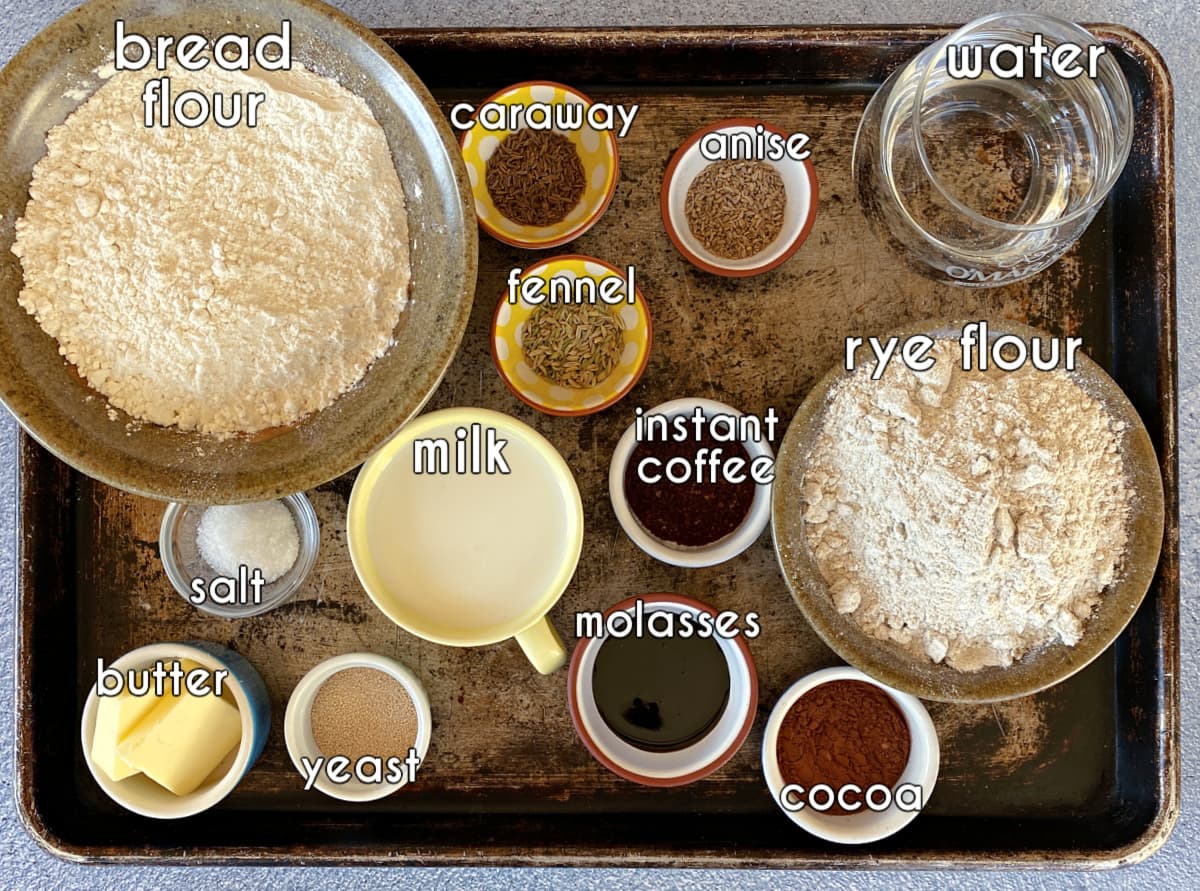
★ Bread flour: For this recipe, it is important to use bread flour; not all-purpose flour. I use Bob's Red Mill Artisan Bread Flour for all my bread baking. (We are lucky enough to live only about an hour from Bob's Red Mill so we can easily restock.)
Bread flour contains higher amounts of protein and gluten. The extra protein lends structure to this dough, allowing it to lift and hold its shape better. The extra gluten helps balance out the relative lack of gluten in the rye flour.
★ Rye flour: This recipe was tested using both King Arthur Organic Medium Rye Flour and Bob's Red Mill Organic Dark Rye Flour, in separate batches. Both flours worked equally well, and there was little, if any, difference in flavor of the breads.
★ Seeds: The combination of three seeds - fennel, anise, and caraway - gives this rye bread its distinctive flavor.
Some folks have strong opinions about the seeds in rye bread; particularly about caraway seeds. If you want to leave one or more of the seeds out, go ahead. They don't affect the overall bake, but omitting them dramatically affects the flavor of the bread.
★ Milk: Adding milk to bread dough produces a softer, more supple loaf than water alone, due to its higher fat content.
I always use whole milk when making bread. Milk can either be fresh, or rehydrated from dried milk.
Do not use all milk/no water in this recipe. The amount of yeast is balanced for the sugars in the molasses and milk. Changing the ratio requires adjusting the amount of yeast.
★ Butter: Use real, salted butter.
★ Yeast: Use regular active dry yeast. Do not use rapid rise yeast.
Color and Flavor Agents
Rye flour bakes naturally to a grey-blue color, and bread made with it can have a less than appealing appearance. For centuries now, bakers have added molasses, coffee, and/or cocoa to give dark rye dough its signature deep chocolate color.
★ Instant coffee: Use either regular or decaf instant coffee. Coffee enhances both the flavor and color of the bread.
You can substitute a cup of room temperature coffee for the instant coffee and water in the recipe.
★ Cocoa: Use a Dutch processed baking cocoa powder. Dutch processed cocoa isn't acidic like natural cocoa powder is. Acid weakens gluten and breaks it down; something you want to avoid especially when making bread that naturally has less gluten to begin with, like rye bread.
★ Molasses: Use light or dark molasses. Do not use blackstrap molasses.
How to Make the Best Dark Rye Bread
Note: I usually mix and knead rye dough in a stand mixer; however, the dough can also be mixed entirely by hand.
Mix Dough
Combine fennel seeds, anise seeds, and caraway seed in a spice grinder, clean coffee grinder, or mortar & pestle and grind until the mixture is the texture of medium-grind cornmeal.
In a large bowl, whisk together white and rye flours, cocoa, instant coffee, salt, and the ground seed mixture. Set aside.
In a medium saucepan over medium-low, heat the milk, molasses, and butter until the butter melts and the mixture is barely beginning to bubble just around the edges of the pan. Remove from heat.
Stir in the water. The mixture should register 105°-115°F| 40°-43°C on an instant-read thermometer. If it is hotter, allow it to cool before continuing.
Stir the yeast into the warm milk mixture. Let it stand until the yeast becomes foamy; 3-5 minutes.
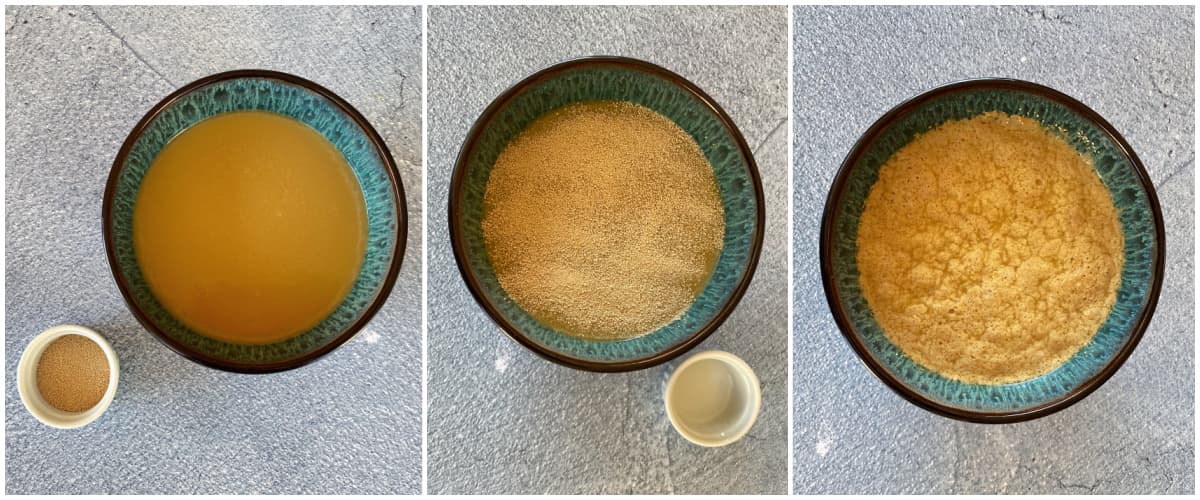
Pour the wet mixture into the bowl of an electric stand mixer.
With the mixer on low, slowly add the dry flour mixture to the milk mixture, scraping the bowl as necessary.
Mix on low until the flour and milk mixture are thoroughly combined. The dough will be quite sticky.

Knead
Important: If, after kneading the dough for a couple of minutes, the dough continues to be sticky and unstructured, sprinkle in up to ¼ cup additional bread flour. (See Adjusting for External Factors for more.)
Kneading with a Stand Mixer
Using a bread hook, knead the dough for about 10 minutes; until it appears resilient and smooth, and no longer sticks to the edges of the mixing bowl.
Kneading by Hand
Spread a tablespoon or two of oil on your bread-kneading surface. Knead the dough by hand for 8-12 minutes; until it is smooth and resilient.
Rye dough isn't as supple as white bread dough, and has an almost clay-like texture when fully kneaded. When you are done kneading, the dough should no longer stick to your hands.
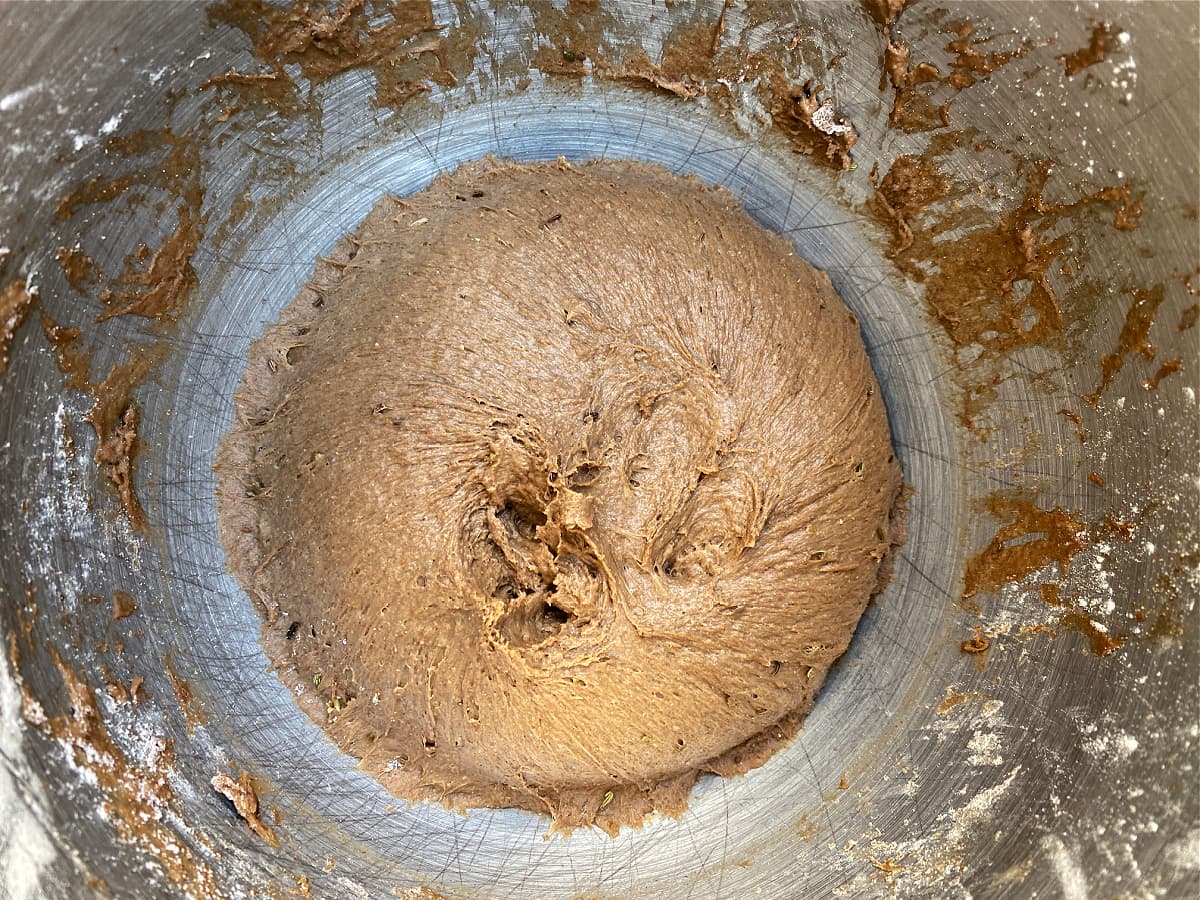
Bulk Fermentation (1st Rise)
Grease a large bowl with vegetable oil. Form the bread dough into a ball and put it in the oiled bowl, turning to coat.
Cover lightly with a damp kitchen towel or greased plastic wrap, and let rise for about 1 - 1½ hours; until it has almost doubled in size. The dough should be light and puffy.
Poke Test
To determine if the dough is done rising, poke a floured finger about ½-inch into the dough. It should feel soft and smooth, and your finger should leave an indent in the dough. If the dough springs back right away, let it rise for a little longer. If the dough springs back slowly, and a small indentation remains, move to the next step.
To grease plastic wrap, spray it lightly with non-stick cooking spray. Ungreased plastic wrap may stick to your loaf.
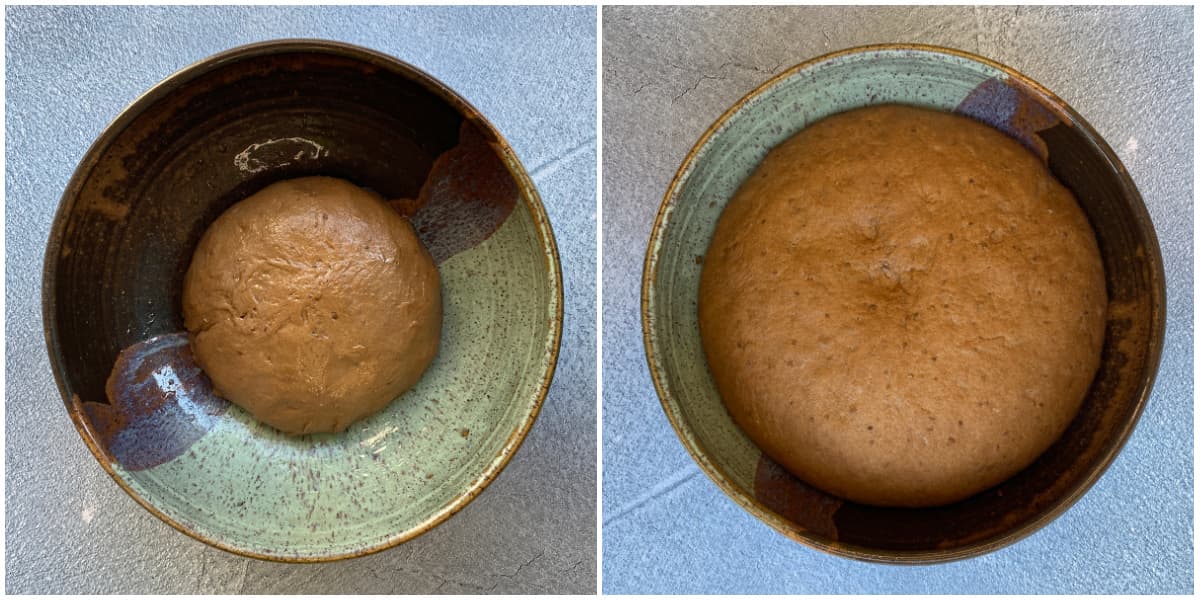
Proofing (2nd Rise)
Gently punch down the dough, and then shape it into either a round or log-shaped loaf, depending on how you plan to bake it.
Place loaf into a floured banneton or brotform proofing basket.
I prefer to use a proofing basket and bake on a baking stone, especially when making rye and sourdough bread. If you don't have a proofing basket, then use a parchment-lined 8x4-inch bread loaf pan.
Cover the loaf of dough lightly with a damp kitchen towel or greased plastic wrap, and allow it rise for 30-45 minutes. Poke it again to determine if it is ready to bake.
Rye dough does not fully double on the second, proofing rise; it will be closer to a 50-70% increase.
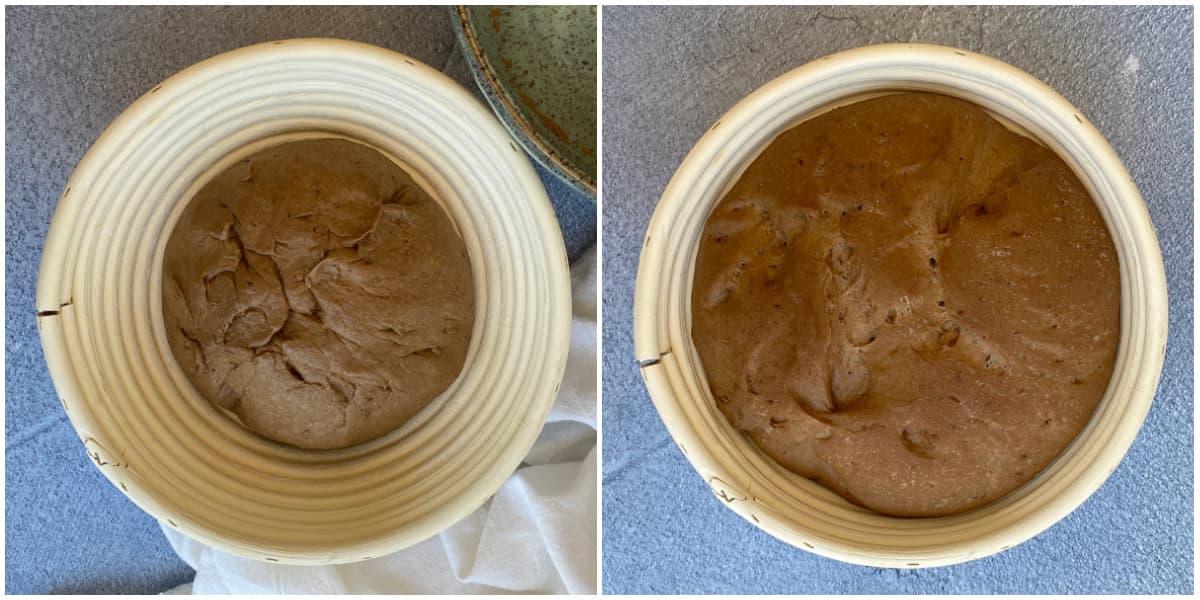
Prep to Bake
Preheat Oven
Preheat oven to 400°F (177°C) about half an hour before the loaf will go in to bake, placing the baking rack in the center of the oven.
For this loaf, I highly recommend using a baking stone if you have one. Place the stone in the oven before you begin preheating the oven.
It is important that the oven is fully heated when the bread is ready in so the bread doesn't slump as it waits to be put in the oven.
Prep the Loaf
Add any seeds or oatmeal you want to the top the loaf with at this time.
Using a sharp, wet knife, slash the top of the loaf a few times right before putting it in the oven.
Rye bread doesn't have the same kind of dramatic oven rise that white bread often does, so if you forget to slash it- no worries, but doing so does help to encourage even baking.
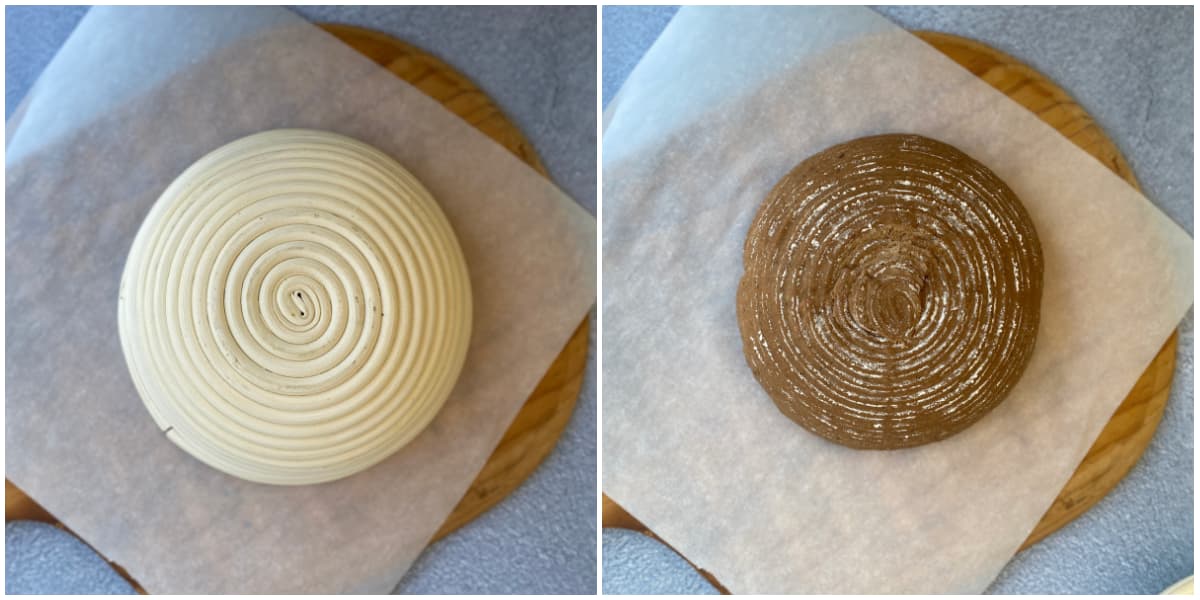
Bake
Put loaf in the preheated oven, on a baking stone if you are using one.
Use a clean mister filled with water to mist the loaf and the inside of the oven. Misting prevents the outer layer of the dough from drying out, allowing the bread to rise more freely and keeping it from browning too quickly.
Bake for 30-35 minutes. When the loaf is fully baked, the bread should sound hollow when thumped, and an instant-read digital thermometer should register 190°F (88°C).
Remove the bread from the oven, and place it on a rack to cool. If you bake the bread in a loaf pan, turn the loaf out after 10 minutes.
Bread continues to bake internally for a few minutes after it comes out of the oven, so it is important to let it cool naturally before slicing.
High-Altitude Rye Bread Baking Tips
Baking rye bread above 3,000 feet? Altitude can affect everything from structure to baking temperature. Here are a few tips one high-altitude home baker shared with us:
- Use a loaf pan, especially if you are just learning to bake at high altitude. Rye bread can really struggle to hold shape.
- Add 1.5 teaspoons of vital wheat gluten per cup of flour to strengthen the dough.
- Reduce the yeast slightly to slow down the rise.
- Try a cold rise in the fridge to give the dough more time to develop flavor and structure.
- Reduce the liquid slightly (1 tablespoon per cup of flour) to tighten up the dough.
Here are a couple more helpful tips:
- Increase the oven temperature by 15-25°F to set the crust faster and prevent over-expansion.
- Allow the dough to rise only until it doubles in size. Rising times are much faster than at sea level, so keep an eye on it!
- Since lower air pressure at high altitudes can slow down baking, you may need to extend the bake time by 5-10 minutes.
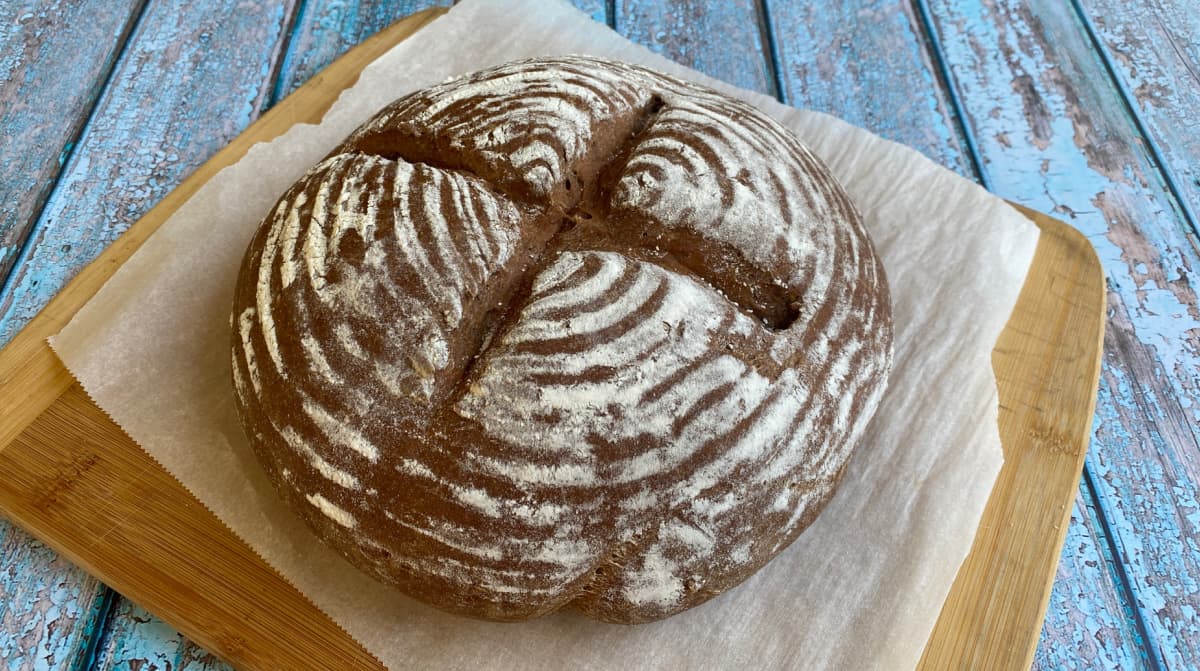
Want a real treat? Cut a couple of slices of fresh dark rye, and make yourself an awesome Reuben sandwich!
Is this authentic German Dark Rye Bread?
It depends on which side of the Atlantic you stand.
Old World German Rye Bread, known as Roggenbrot, contains only rye flour. It is almost always made with rye sourdough, and has a rough, notably rustic texture. Schwarzbrot (German black bread) and traditional pumpernickel rye bread fall into this category.
This dark rye bread recipe contains both wheat and rye flours and is leavened using baker's yeast. This softer, hybrid-style dark rye is what you are likely most familiar with if you live the in the US. It is known in Germany as Roggenmischbrot (mixed rye bread).
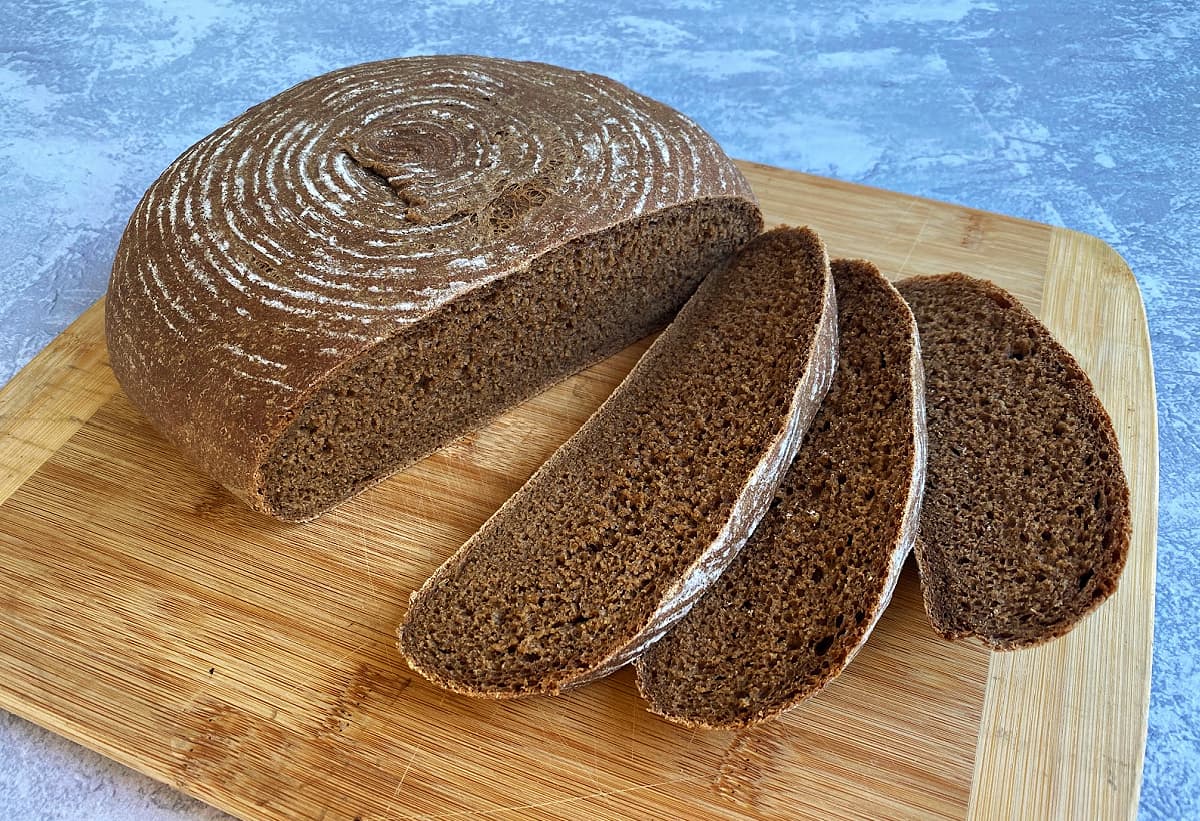
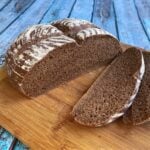
German Dark Rye Bread
Equipment
- 1 Stand Mixer optional
- 1 clean kitchen towel or plastic wrap
- 1 proofing basket or parchment lined 8x4-inch bread loaf pan
- 1 baking stone or
- 1 spice grinder or clean coffee grinder, or small mortar and pestle
Ingredients
- 1½ teaspoons anise seeds
- 1½ teaspoons fennel seeds
- 1½ teaspoons caraway seeds
- 2¼ cups bread flour
- 1½ cups dark rye flour
- 4 teaspoons baking cocoa
- 1½ teaspoons instant coffee
- 1½ teaspoons sea salt
- 1 cups water room temperature
- ½ cup whole milk
- 2 tablespoons butter
- 2 tablespoons molasses
- 3 teaspoons active dry yeast
- canola oil or any neutral cooking oil
Instructions
Mix Dough
- Combine fennel seeds, anise seeds, and caraway seed in a spice grinder, clean coffee grinder, or mortar & pestle, and grind until the mixture is the texture of medium-grind cornmeal.In a large bowl, whisk together white and rye flours, cocoa, instant coffee, salt, and the ground seed mixture. Set aside.
- In a medium saucepan over medium-low, heat the milk, molasses, and butter until the butter melts and the mixture is barely beginning to bubble just around the edges of the pan. Remove from heat.Stir in the water. The mixture should register 105°-115°F| 40°-43°C on an instant-read thermometer. If it is hotter, allow it to cool before continuing.Stir the yeast into the warm milk mixture. Let it stand until the yeast becomes foamy; 3-5 minutes.
- Pour the wet mixture into the bowl of an electric stand mixer.With the mixer on low, slowly add the dry flour mixture to the milk mixture, scraping the bowl as necessary.Mix on low until the flour and milk mixture are thoroughly combined. The dough will be quite sticky.
Knead
- Important: If, after kneading the dough for a couple of minutes, the dough continues to be sticky and unstructured, sprinkle in up to ¼ cup additional bread flour.
- Kneading with a Stand Mixer: Using a bread hook, knead the dough for about 10 minutes; until it appears resilient and smooth, and no longer sticks to the edges of the mixing bowl.
- Kneading by Hand: Spread a tablespoon or two of oil on your bread-kneading surface. Knead the dough by hand for 8-12 minutes; until it is smooth and resilient.Rye dough isn't as supple as white bread dough, and has an almost clay-like texture when fully kneaded. When you are done kneading, the dough should no longer stick to your hands.
Bulk Fermentation (1st Rise)
- Grease a large bowl with vegetable oil. Form the bread dough into a ball and put it in the oiled bowl, turning to coat.Cover lightly with a damp kitchen towel or greased plastic wrap, and let rise for about 1 - 1½ hours; until it has almost doubled in size. The dough should be light and puffy.
- Poke Test: To determine if the dough is done rising, poke a floured finger about ½-inch into the dough. It should feel soft and smooth, and your finger should leave an indent in the dough. If the dough springs back right away, let it rise for a little longer. If the dough springs back slowly, and a small indentation remains, move to the next step.
Proofing (2nd Rise)
- Gently punch down the dough, and then shape it into either a round or log-shaped loaf, depending on how you plan to bake it.
- Place loafs into either a floured banneton (proofing basket) or parchment lined 8x4-inch bread loaf pan.Cover the loaf of dough lightly with a damp kitchen towel or greased plastic wrap, and allow it rise for 30-45 minutes. Poke it again to determine if it is ready to bake.Rye dough does not fully double on the second, proofing rise; it will be closer to a 50-70% increase.
Prep to Bake
- Preheat oven to 400°F | 177°C about half an hour before the loaf will go in to bake, placing the baking rack in the center of the oven.Use a baking stone if you have one. Place the stone in the oven before you begin preheating the oven.It is important that the oven is fully heated when the bread is ready in so the bread doesn't slump as it waits to be put in the oven.
- Add any seeds or oatmeal you want to the top the loaf with at this time.Using a sharp, wet knife, slash the top of the loaf a few times right before putting it in the oven.
Bake
- Put loaf in the preheated oven, on a baking stone if you are using one.Use a clean mister filled with water to mist the loaf and the inside of the oven. Misting prevents the outer layer of the dough from drying out, allowing the bread to rise more freely and keeping it from browning too quickly.
- Bake for 30-35 minutes. When the loaf is fully baked, the bread should sound hollow when thumped, and an instant-read digital thermometer should register 190°F | 88°C.
- Remove the bread from the oven, and place it on a rack to cool. If you bake the bread in a loaf pan, turn the loaf out after 10 minutes.Bread continues to bake internally for a few minutes after it comes out of the oven, so it is important to let it cool naturally before slicing.
Notes
Nutrition
This website provides approximate nutrition information for convenience and as a courtesy only. You are solely responsible for ensuring that any nutritional information provided is accurate, complete, and useful.
Love it? Pin it! If you love this German Dark Rye Bread recipe, be sure to save it! Pin it to your favorite Pinterest recipe board before you go!
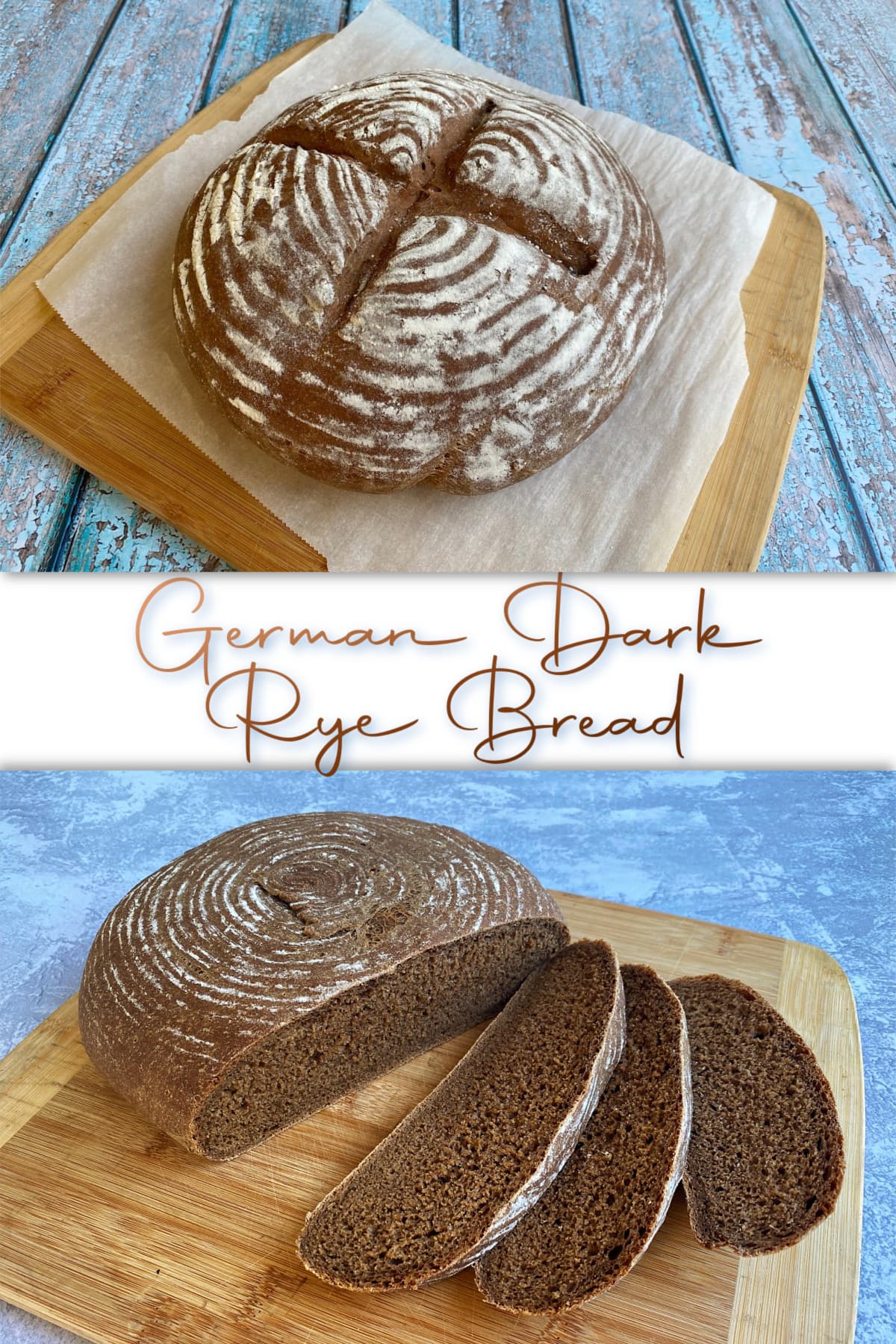

Want More Free Recipes?
Subscribe to our newsletter to get family-friendly recipes and cozy living ideas in your inbox each week!
Find us on Instagram, Pinterest, and Facebook, too.
Thank you for visiting the Good Hearted Woman. Remember to bookmark this site, and come back soon!




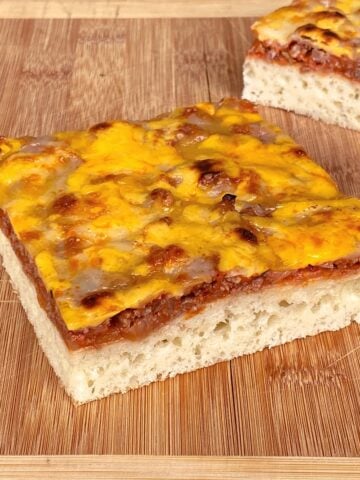
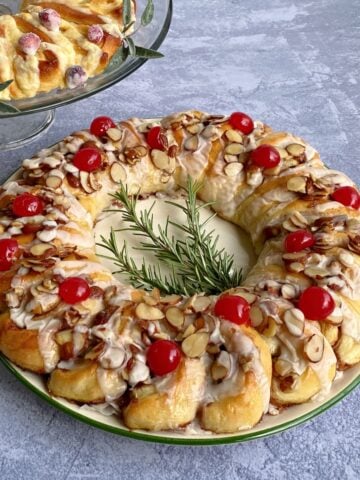

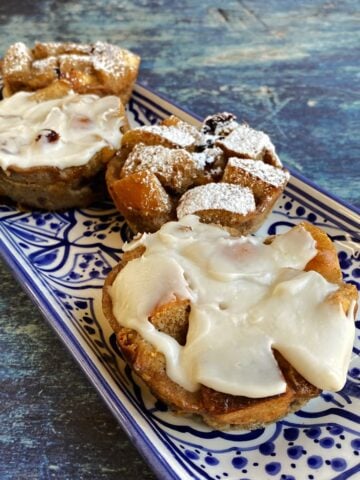
Becky Vidrine says
When using frozen cherries do I thaw them and drain them first before putting them into the baking dish? Or do I put the frozen cherries directly into the baking dish?
Renée B. says
Yes! If you’re using frozen cherries, it’s best to thaw and drain them first so your clafoutis bakes up nice and custardy instead of watery. Also, I think this question was meant for the Cherry Clafoutis recipe (easy mix-up!) – you can find it here: Classic Cherry Clafoutis.
Laurie LeBlanc says
Wow! This bread is AMAZING! My teenage kids love it, too! This is going to be a weekly addition to our pantry.
Thank you so much for sharing your recipe so that we could enjoy this delicious bread. I never would have thought to put all those things in it!
Blessings and Shalom,
Laurie
Renée B. says
I’m so glad this bread was such a hit in your house! A weekly addition to the pantry is the best compliment I could hope for. You picked up on exactly what I love about it too – the way those flavors surprise you and then just work. Thank you for sharing your experience—it truly made my day!
Sharron weir says
I made this last week and it turned out real good and I did use blackstrap molasses, but I would like to make more than one loaf at a time so I’m not too sure if I can double everything or just part of it
Honey Bee says
Renee, can I make this in a loaf pan? I live at altitude, and it may help me corral the dough to stay together more. Thx!
Renée B. says
You can certainly bake this in a loaf pan - just be sure to use a heavy duty one. I don't have much personal experience with high-altitude baking above 2000 feet, but I've read that containing the dough can help maintain its shape and bake more evenly. Let me know how it turns out!
Honey Bee says
For high-altitude I need a loaf pan, at least at this time in my skills. I added 1.5 t of vital wheat gluten, per cup of flour. I needed about 1 tablespoon more of flour in the mixing phase. I will likely cut down the yeast as it was very quick and responsive, which then the bread cannot hold the lift as well as at sea level. A slow cold rise may help??? All of the rising times were super fast. It was family winner. We will make this again with subtle changes for high-altitude.
Renée B. says
Thanks so much for sharing your experience! Adding vital wheat gluten is a smart move to strengthen the structure, especially since rye can struggle to hold shape. Cutting back on the yeast should definitely help slow things down, giving the dough more time to develop flavor and structure. A cold rise in the fridge is also a great idea to extend the fermentation time. If the rise is still too quick, you might also try lowering the liquid slightly to tighten up the dough.
I'll be adding your comments into the post. I'm sure there are a lot of high-altitude bakers who just avoid rye bread altogether because it can present such a challenge. Thank you again!
Ella says
Absolutely delicious bread
Renée B. says
So glad you love it! Happy baking!
Annie Clein says
Hello Renée, why do you advise not to use blackstrap molasses?
Renée B. says
Blackstrap molasses is derived from a third boiling process, and is darker, thicker, and less sweet as compared to dark molasses. Unlike light and dark molasses, it cannot be use interchangeably in cooking. Not only will using blackstrap change the sugar balance in this recipe, but its intense flavor can overpower other, more delicate flavors working in the bread.
Annie says
Thank you Renée, that makes sense that it would be overpowering, and also apologies, as I see someone else had already asked my question earlier! But, I don't know where to find light / dark molasses here in the UK, I can only see blackstrap...
Renée B. says
While I've never used it myself, based on what I can surmise, treacle should make a good substitute in this case. Treacle tends to be sweeter and less bitter than molasses, but it shouldn't impact the flavor of the bread much (if at all).
If you make this recipe using treacle, please check back and let us know how it went!
Julia says
First time attempting this recipe and I baked it in my pressure cooker on bake setting. It's delicious and I will make it again with dark rye rather than just rye
Renée B. says
I'm so glad your first attempt turned out so delicious! I've never baked bread in a pressure cooker, and I'm intrigued – did it affect the texture or flavor in any unique way? Happy baking! 🍞 😊
Adrienne says
Made this wonderful recipe this morning. I substituted honey for the molasses since I accidentally grabbed the blackstrap on my last shopping trip. I also used 2 cups of rye flour right from the beginning. I don’t have a stand mixer so I did all the kneading by hand. This dough rose beautifully as I placed it on the table near to our wood burning stove. I bake all my breads in a parchment lined cast iron Dutch oven. I baked at 450 degrees, covered for 25 minutes and then uncovered for another 15. The bread looks beautiful! I can’t wait to eat it with some braunschweiger and mustard!
Renée B. says
Oh my, that sounds fabulous! Thanks for the great input on your process, too!
Gwen says
Can I use a dutch oven for baking? I do not have a stone.
Renée B. says
I've never baked this bread in my Dutch oven, but I imagine you can. I'll have to test it out next time I bake a loaf!
Preheat the DO, and then drop the raised loaf in on parchment when you are ready to bake it, just as you would a rustic bread or sourdough loaf.
Robert says
Great recipe!
Very tasty and the texture is amazing.
Even better the next day!!
Thank you for the recipe, Renee!
Renée B. says
Thank you for the kind words, Robert! You raise a good point, too: unlike many "white breads," the flavor and texture of rye bread seems to improve if it is given a day to rest before eating.
jrkrideau says
Thank you. I have managed to mess up trying to make rye bread for years. Simple white or whole wheat bread is easy and automatic.
Now some decent guide-lines and rationales.
YES!
Renée B. says
Rye bread is tricky, for sure! It took so many test loaves to work this recipe out, and I'm glad the efforts are helpful to you!
Fred says
Tried this recipe multiple times and not once did it work. Always a big sticky pile of mush that no amount of hand kneading, extra flour or stand mixer kneading could fix.
Renée B. says
That is so frustrating! I'm confident about the recipe: it has been made successfully hundreds of times at this point, so let's try to do a little problem-solving. First, are you weighing your ingredients? This is almost a requirement when making bread. If you are already weighing, then consider reducing the water by 2-3 tablespoons and increasing the flour by 1/4-1/2 cup.
robert says
Hello Fred.
I am a male also (home cook) and tried this recipe for the first time.
Once you get the quantities correct dump it all in the stand mixer with a dough hook. Yes, it will be sticky, then add a spoonful of rye flour (let it mix) until it isn't sticky! It works. I ended up putting 4 extra spoons of flour (advised by Renee) and it worked.
Pour some oil on your bench/surface then take the mix out and kneed it. It makes a wonderful texture once baked!
Maria says
Why should we avoid blackstrap molasses?
Renée B. says
Light or regular molasses is produced after the second boiling, and retains a sweet profile. Blackstrap molasses is what comes from a third boiling, and it's very bitter. This will make your bread take on an offensive, bitter flavor. Blackstrap molasses can also expose you to chemicals including lead and acrylamide, which are known to cause cancer and birth defects or other reproductive harm.
Nick says
Although salt is listed in the ingredients, it is never included in the instructions. Alas, I left it out and the loaf tasted quite flat.
Renée B. says
Thank you for letting me know: salt is critical to bread success. Both recipe and post have now been updated with instructions for when to add the salt.
Charles says
I appreciate the effort you've put into this beautiful recipe for German Dark Rye Bread!
I cannot wait to try it! Thanks for sharing!
Renée B. says
Thanks so much! Enjoy!
Dionne says
I think I will be making this bread over and over again... It is so much better than the one I am currently buying.
Nathan says
This looks like the perfect homemade rye! Can't wait to try it out for myself, thanks so much for the recipe 🙂
Amy says
Thank you so much for this recipe. I love rye bread and have always wanted a recipe I could make at home since I get it at a restaurant.
Elizabeth says
Oh how I love rye bread. This looks so delicious. Can't wait to try it!